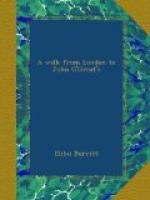Crossing the Nen, I followed it for several miles in a northerly direction. I soon came to a rather low, level section of the road, and noticed stones placed at the side of it, at narrow intervals, for a long distance to the very foot of a village situated on a rising ground. These stones were evidently taken from some ancient edifice, for many of them bore the marks of the old cathedral or castle chisel. They were the foot-tracks of a ruined monument of dark and painful history. More than this might be said of them. They were the blood-drops of a monstrosity chased from its den and hunted down by the people, who shuddered with horror at its sanguinary record of violence and wrong. As I approached the quiet village, whose pleasant-faced houses, great and small, looked like a congregation of old and young sitting reverently around the parish church and listening to the preaching of the belfry, I saw where these stones came from. There, on that green, ridgy slope, where the lambs lay in the sun by the river, these stones, and a million more scattered hither and thither, once stood in walls high, hideous and wrathful, for half a dozen centuries and more. If the breathings of human woe, if the midnight misery of wretched, broken hearts, could have penetrated these stones, one might almost fancy that they would have sweat with human histories in the ditch where they lay, and discolored the puddles they bridged with the bitter distilment of grief centuries old. On that gentle rising from the little Nen stood Fotheringay Castle. That central depression among the soft-carpeted ridges marks the site of the donjon huge and horrid, where many a knight and lady of noble blood was pinioned or penned in darkness and hopeless duress centuries before the unfortunate Mary was born. There nearly half the sad years of her young life and beauty were prisoned. There she pined in the sickness of hope deferred, in the corroding anguish of dread uncertainty, for a space as wide as that between the baptismal font and presentation at Elizabeth’s court. There she laid her white neck upon the block. There fell the broad axe of Elizabeth’s envy, fear and hate. There fell the fair-haired head that once gilded a crown and wore all the glory of regal courts—still beautiful in the setting light of farewell thoughts.
It may be truly said of Fotheringay Castle, that not one stone is left upon another to mark its foundations. Not Fleet-street Prison, nor the Bastille itself, went out under a heavier weight of popular odium. Although public sentiment, as well as the personal taste and interest of their proprietors, has favored the preservation of the ruins of old castles and abbeys in Great Britain, Fotheringay bore, branded deep in its forehead, the mark of Cain, and every man’s hand, of the last generation, seemed to have been turned against it. It has not only been demolished, but the debris have been scattered far and wide, and devoted to uses which they scarcely honor. You will see the well-faced stones for miles around, in garden walls, pavements, cottage hearths and chimneys, in stables and cow-houses. In Oundle, the principal hotel, a large castellated building, shows its whole front built of them.




